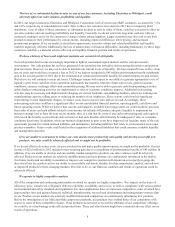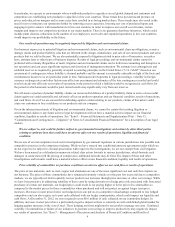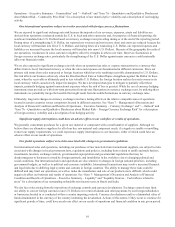Tecumseh Products 2012 Annual Report Download - page 19
Download and view the complete annual report
Please find page 19 of the 2012 Tecumseh Products annual report below. You can navigate through the pages in the report by either clicking on the pages listed below, or by using the keyword search tool below to find specific information within the annual report.18
Commodities
Due to the high content of copper and steel in compressor products, our results of operations are very sensitive to the prices of
these commodities.
The weighted average market costs for the types of copper used in our products decreased 11.6% in 2012 as compared to 2011.
After consideration of our hedge positions, our weighted average cost of copper in 2012 was 4.4% lower in our results of
operations when compared to 2011, primarily due to our hedge positions relative to the market. Extreme volatilities create
substantial challenges in our ability to control the cost of our products, as the final product cost can depend greatly on our
ability to secure optimally priced futures contracts.
The weighted average market costs for the types of steel used in our products decreased 9.4% in 2012 as compared to 2011.
Any rapid increase in steel prices has a particularly negative impact on our product costs, as there is currently no well-
established global market for hedging against increases in the price of steel. Although we have been successful in securing a
few contracts to help mitigate the risk of the rising steel market, this market is not very liquid and only available against our
U.S. steel purchases.
Based upon the introduction of the new Mini and Midi platforms, we used more aluminum in our motors in 2012 and expect to
continue this trend in 2013. While aluminum is currently not as volatile as copper and steel, we have proactively executed
some futures contracts for aluminum to help mitigate the risk of rising aluminum prices.
We have been proactive in addressing the volatility of copper and aluminum costs, including executing futures contracts, as of
December 31, 2012 to cover approximately 32.6% and 30.7% of our anticipated usage in 2013, respectively. However;
continued volatility of these costs could nonetheless have an adverse effect on our results of operations both in the near and
long term as our anticipated needs are not 100% hedged.
While the use of futures can mitigate the risks of price increases associated with these commodities by “locking in” prices at a
specific level, they also reduce the benefits of price decreases associated with these commodities. In addition, declines in the
prices of the underlying commodities can result in downward pressure in selling prices, particularly if competitors have lesser
future purchase positions, thus causing a contraction of our margins.
We expect to continue our approach of mitigating the effect of short-term price swings of commodities through the appropriate
use of hedging instruments, price increases and modified pricing structures with our customers, where available, to allow us to
recover our costs in the event that the prices of commodities escalate. Due to competitive markets for our finished products, we
are typically not able to quickly recover product cost increases through price increases or other cost savings. For a discussion
of the risks to our business associated with commodity price risk fluctuations, refer to “Quantitative and Qualitative
Disclosures about Market Risk – Commodity Price Risk” in Part II, Item 7A of this report.
Currency Exchange
The compressor industry, and our business in particular, are characterized by global and regional markets that are served by
manufacturing locations positioned throughout the world. Most of our manufacturing presence is in international locations.
During each of 2012 and 2011, approximately 80% of our compressor sales activity took place outside the U.S., primarily in
Brazil, Europe, and India. As a result, our consolidated financial results are sensitive to changes in foreign currency exchange
rates, including the Brazilian Real, the Euro and the Indian Rupee. Ultimately, long-term changes in currency exchange rates
have lasting effects on the relative competitiveness of operations located in certain countries versus competitors located in
different countries. Only one major competitor of our compressor business faces similar exposure to the Brazilian Real. Our
Brazilian and European manufacturing and sales presence is significant and changes in the Brazilian Real and the Euro have
been especially harmful to our results of operations when compared to prior periods. The Brazilian Real experienced significant
volatility against the U.S. Dollar during 2011. During the first half of 2011, the Brazilian Real strengthened against the U.S.
Dollar by 6.3%, which was followed by a 20.0% weakening during the second half of 2011, showing significant swings from
month to month. During 2012, the Brazilian Real and the Indian Rupee weakened against the U.S. Dollar by 8.9% and 3.7%,
respectively, while the Euro strengthened against the U.S. Dollar by 1.8%, compared to 2011. For a discussion of the risks to
our business associated with currency fluctuations, refer to “Quantitative and Qualitative Disclosures about Market Risk –
Foreign Currency Exchange Risk” in Part II, Item 7A of this report.
























